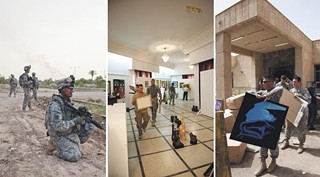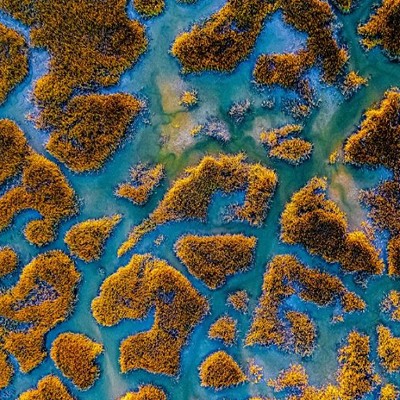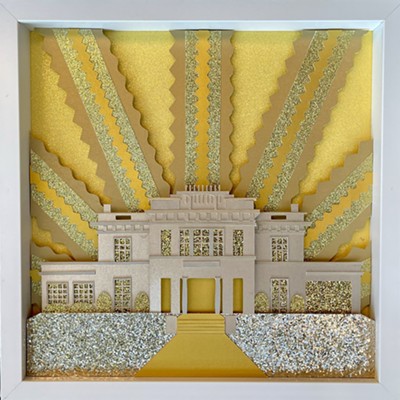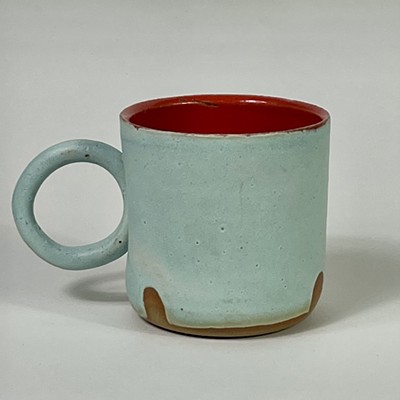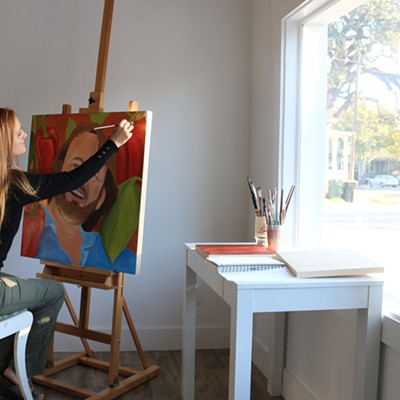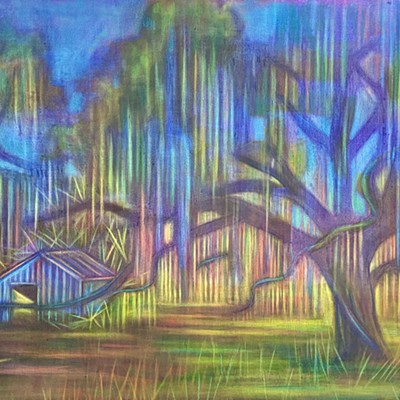On May 17, I stood at the center of an art gallery. I looked around, observing the paintings and sculptures that decorated the walls and accented the room.
I felt as though I was in New York City’s Museum of Modern Art, or the Metropolitan Museum of Art. It was all too easy to immerse myself in the artwork, hoping to discover the story or meaning behind each piece.
I had almost forgotten that I was in the Doura District of Baghdad, Iraq — the same Doura District where numerous IEDs (Improvised Explosive Devices) and suicide bombers have killed American soldiers and innocent Iraqi civilians.
It quickly dawned on me the importance of this art show and the positive impact it could have. It could show the world that Baghdad, a war zone, has become peaceful enough to house a public art show promoting the city’s own art and culture.
The organizer and visionary responsible for the show was Captain Evan Davies, commander of Apache Troop, 5th Squadron, 7th Cavalry, based in Ft. Stewart, Ga.
“The art show demonstrated Doura’s and, in actuality, the rest of Baghdad’s progress towards a return to normalcy,” says Capt. Davies. “The ability and desire to hold an art show is a significant step in the resurgence of culture in this formerly war–torn area.”
Often referred to as the birthplace of the insurgency, Doura lies in the southern portion of Baghdad’s urban area. It has always been a contested area, and has seen some of the fiercest fighting in the region on a daily basis.
In order to remove the negative reputation Doura bears, Capt. Davies wanted to create an event which would essentially express how much it has changed.
Capt. Davies and Apache Troop worked hand in hand with local community leader and cardiologist, Dr. Muayad Muslih Hamad al–Jabori, to plan and host the show. Dr. Muayad has played a key role in both the organization of the art show and in cleaning up his neighborhood of Doura.
“He has worked with United States Forces since the beginning, developing projects to employ the local citizens of Doura in Southern Baghdad, and steer them away from the insurgency,” says Capt. Davies. “His actions, and steadfast loyalty to the common citizen of Doura, set him apart from many others who fled the region in a crucial period of time.”
Working with Capt. Davies and Dr. Muayad was a legendary Iraqi artist, Laith Altark, whose sculptures and monuments can be seen around Baghdad. Laith was responsible for personally choosing the most talented artists in Baghdad and Iraq to display their work at the show.
Laith is a lively old man, passionate and dedicated to his craft. As seen through the hard work he put into the show, it is clear he desires the art community to flourish once again.
Some of the artists are professors and students of the Baghdad College of Fine Arts. Besides art shows at the college, they haven’t had many recent opportunities to show their art to the public.
“The last three years, there has been maybe one show a year,” says Nibras Hashim, professor at Baghdad College of Fine Arts. “In 2009, there were no art shows.”
Though the artists are looking for a chance to share their creativity with the community, they have a much bigger vision in mind.
“I like the idea of building a relationship with other cultures and telling the world that Iraq doesn’t have just IEDs,” says Sabah Hamad, one of the show’s artists. “It’s not just full of politicians and war. We have the arts. We have culture.”
Talking with Sabah reinforces the goal Capt. Davies is trying to achieve: Nourish Iraqi art and culture while showing the world that Baghdad has changed for the better.
“The art is a message. People used to be afraid of Doura. I cannot believe it is the same place. Safe and secure; this is the message to the people, and Doura especially. It is secure. The first Iraqi artists came to show their work, and we wish that the rest in Baghdad would do the same, this art show is a challenge to those areas to do this,” said the chairman of the Arab Journalists Union during an interview with Al–Aiyar TV.
With similar feelings, the Sheik’s Support Council said, “This is what Iraq means. This is truly how to fight for your country, through an event such as this. I wish to see this kind of art show everywhere, this will refresh the Iraqi mind. Security in Doura is very important; with this art show, we are demonstrating how safe and secure it has become.”
During the show, I saw Iraqi Federal police, Sheiks, citizens, local and international media, and American soldiers all within the same gallery. They were all there to enjoy art and, indirectly, rebuild and strengthen relationships amongst each other and between American forces.
From my American civilian perspective, I would assume events like this might happen regularly. But unfortunately, these opportunities are rare.
“One of the more positive effects that resulted from this show was the collaboration between the Iraqi Security Forces, local civic leaders, and Iraqi government officials,” says Capt. Davies.
“All that the United States Forces contributed was the original idea. The remainder was the result of Iraqi ingenuity and creativity.”
The art show was groundbreaking in many regards. It gave 40 of the most prominent Iraqi artists the opportunity to share their work. Before 2003, these artists would hold exhibitions all over the world, from the United States and Europe to the far reaches of Asia.
Recently, smaller shows were held in the urban core of Baghdad, but an assembly of such influential and noteworthy artists has never been assembled in the Doura District of Baghdad to date.
This show allows the world to see that life in Baghdad is returning to normalcy thanks in part to the hard work and sacrifice American forces continue to contribute.
From my point of view, I’m astounded by the work and accomplishments of the U.S and Iraqi forces. It proves that there’s more to Baghdad than violence.
The community is being rebuilt and strengthened. Art and culture is beginning to flourish again. Doura is letting the world know that it has changed.
I can only hope for Doura and its people that this progress will continue for years to come.
To comment, email us at [email protected]

